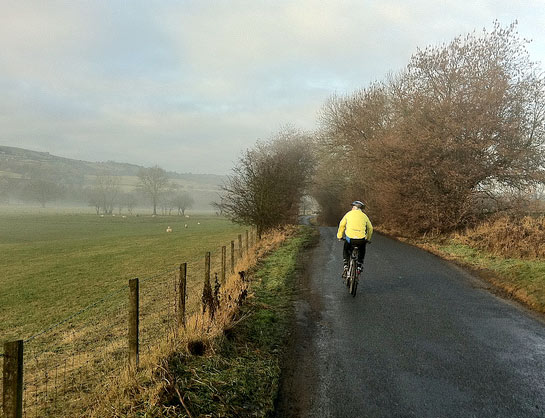Delayed onset muscle soreness (DOMS), also called delayed muscle fatigue – the pain and stiffness felt in muscles several hours and days after unaccustomed exercises caused by the microtrauma in the untrained muscles
Recently I wrote a post on cycling vs running. I was boasting how I always tried to avoid running because if I do go running, my muscles are sore the next day, due to being completely untrained.
Instead I went out yesterday on the time trial bike. It was only the second outing of the year. In the New Year, I always look to start training on my time trial bike, so I can get used to the position for upcoming races. The problem is that with a new bike, I don’t want to go out, if the roads are wet and salty. Every day since 1 Dec, I’ve looked at the state of the roads, and they are never dry, and – invariably salty too. The only use the TT bike has had is the odd hour on the rollers – and so far this year, I’ve never had any motivation to spend more than an hour on the rollers.
This week, the weather is marginally better. Above freezing. The roads aren’t dry, but at least there are no puddles, so I took the plunge and got out on the new TT bike and got my head down.
It’s a mixed emotion of getting on the TT bike, after three months of riding the winter training hack. Firstly, you’re much faster for the same effort. I’m guessing 2-3mph faster. On a time trial bike, you can just get everywhere quicker. From Oxford there is 15 miles of flat to get to the Chilterns. With a TT bike, it’s a breeze to get to the foothills, with the winter training bike you feel worn-out and ready to turn back by the time you get to the bottom of the Stokenchurch climb.
I was enjoying the ride quite a lot, I choose a few gradual climbs and went up and down the Chiltern Ridge, places like Stokenchurch, West Wycombe, Bledlow Ridge, Great Hampden, Bryant’s Bottom and to finish off Whiteleaf hill (which is not a gradual climb)
I spent four hours and did around 72 miles. I wasn’t always in the TT position, but I was for quite a lot of time. As usual it is hard work holding the position. That’s the flip side of being faster – it’s more uncomfortable. I can’t believe the pressure put on your upper arms and neck.
I got home fairly happy. It was a good training ride, and it was enjoyable to get more used to the TT bike. The problem was the next day. My upper back and shoulders felt like they had been in the wars or rowing down the Thames for 12 hours.. It would have been more sensible to build up time on the TT bike. Going from one hour to four hours was a big leap my shoulders didn’t appreciate. I was suffering delayed muscle fatigue. At least I know what it feels like to run 10km without doing any running training.
First race of the year on Sun, Redhill CC sporting 18 miles.



I must have delayed muscle. fatigue from 1969 when I rode a bike to my 21st.
I have not ridden much since and probably wont start now!
OK, I’ll mend the punctures, and so we can go out for a family cycling trip to Hawes